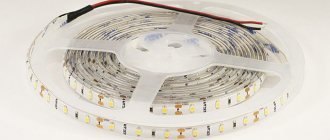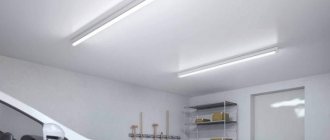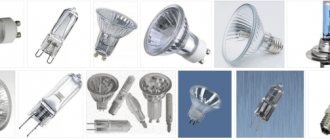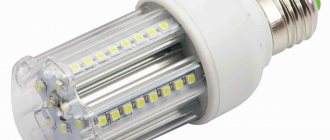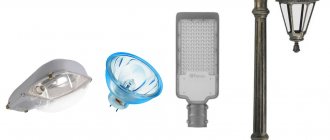Understanding lighting indicators and brightness
Many people are accustomed to choosing light bulbs based on power in watts (W). Previously, when incandescent light bulbs were mainly used, it was indeed possible to focus only on this indicator - the greater the power of the light bulb, the brighter it shone. Times have changed, and now we can use light bulbs that consume less energy and produce more light.
Brightness is affected by the characteristics of the bulbs and the room.
Characteristics of light bulbs that affect brightness:
- luminous flux in lumens (lm);
- power consumption in watts (W);
- luminous intensity in candelas (cd);
- color temperature in Kelvin (K);
- scattering angle;
- color rendering index.
Thus, power consumption in watts is not the only or main factor that reflects brightness.
Room characteristics:
- colors and texture of room surfaces and lampshades;
- height of placement of lamps;
- presence and size of windows.
To understand what a bright room is, we will turn to the SNiP and SanPiN standards (building and sanitary norms and rules), which indicate brightness standards for different rooms. This indicator is given in lux (lx). Lux is a unit of luminous flux in lumens per 1 m² of area. Thus, in order to calculate the required brightness of a room, you need to multiply the indicated recommended number of lux by the number of square meters of the room you want to illuminate - you get the luminous flux in lumens for the whole room.
In this article we will show you how to choose a light bulb based on lumens (often the manufacturer indicates the number of lumens on the box). If you are used to choosing a light bulb by watt, then we will show you how to convert these same lumens into watts.
Second step: calculate the required luminous flux and lamp power
Using examples of different rooms and types of lamps, we show how to calculate which light bulbs are required
If you have any difficulties choosing lamps to achieve the desired level of illumination, please contact us for a free consultation.
For example, before making calculations, let’s decide on the room (we look at the standards to clarify the minimum level of illumination), select the number of lamps based on the scale of the room and design, and the type of lamps.
Attention: do not confuse an LED lamp with a lamp with bulb sockets. If there are bases, then we need to choose light bulbs for them, which, by the way, can be changed. The LED lamp has no bases (with built-in diodes). It doesn't need light bulbs. He himself is like one big light bulb. “It burns out” - we change the entire lamp.
Our premises: a kitchen with an area of 10 m2, we install LED lamps, based on the design we chose a chandelier with 6 bulbs.
Let's look at the standards: according to SNiP and SanPiN, a kitchen needs 150 lx per 1 m2.
We calculate through the luminous flux - lumens (lm).
1. 150 lx * 10 m2 = 1500 lm - required luminous flux (brightness) for the kitchen 2. 1500 lm: 6 = 250 lm - required luminous flux (brightness) of one light bulb
Thus, you need to buy 6 LED light bulbs with a brightness of 250 lm each.
We calculate through power - watts (W).
If you are more accustomed to calculating the total power of lamps for a room in watts, then we convert the luminous flux into power. There is an average of 70 lm per 1W LED light bulb. Keep in mind that LED sources can have very different light output depending on brands and models. In this regard, we recommend calculating using the lumens option, since calculation using watts can often be incorrect.
1) 150 lx * 10 m² = 1500 lm – required luminous flux for the kitchen 2) 1500 lm: 70 lm/W = 21.4 W – required total power for the kitchen 3) 21.4 W: 6 = 3.6 W – power of one light bulb
Thus, you need to buy 6 LED bulbs of 3.6 W each.
If you choose an LED lamp (without bases, with built-in LEDs), then we have already calculated the lighting area for them. Just enter the area and style - you will see all the suitable options among LED lamps (without replaceable lamps).
Our premises: a children's room with an area of 12 m², we install incandescent lamps, based on the design we chose a chandelier with 6 bulbs.
Let's look at the table: according to SNiP and SanPiN, the minimum indicator is 200 lx per 1 m².
We calculate through the luminous flux - lumens (lm)
1. 200 lx * 12 m² = 2400 lm – required luminous flux (brightness) per room 2. 2400 lm: 6 = 400 lm – required luminous flux (brightness) of one light bulb
It turns out that 6 incandescent light bulbs of 400 lm each are required.
We calculate through power - watts (W)
If we do not find lumens on light bulbs, then we need to convert them to watts. There are 10 lm per 1 W of an incandescent light bulb.
1) 200 lx * 12 m² = 2400 lm – required luminous flux per room 2) 2400 lm: 10 lm/W = 240 W – required total power per room 3) 240 W: 6 = 40 W – power of one light bulb
It turns out that 6 incandescent light bulbs of 40 W each are required.
Room area, m²:
Style:
Pick up
Power
One of the main reasons why people prefer LEDs is the low energy consumption compared to incandescent lamps.
So, on average, the rated power of incandescent lamps ranges from 40 to 100 watts. However, if you look at the characteristics of LEDs, this figure is 10 times lower. Thus, if you want to reduce the price tag for paying for electricity, then it is worth purchasing an LED lamp that will serve you for many years.
There is also a table of LED powers, which is worth familiarizing yourself with when making calculations.
Third step: take into account the characteristics of the room to calculate brightness
When the ceilings are high, and you do not lower the chandelier to a level of 2.5–2.7 m, then to obtain a more accurate result, multiply the final calculations by the coefficient from the table.
| Ceiling height | Additional coefficient |
| 2.5 - 2.7 m | 1 |
| 2.7 - 3 m | 1,2 |
| 3 - 3.5 m | 1,5 |
| 3.5 - 4.5 m | 2 |
Also remember that dark colors and matte textures of surfaces (walls, furniture) absorb light, which is why brighter light bulbs are required.
Large windows and white glossy surfaces will brighten the room.
If you have a large room - for example, 20 m² or more, and you find a chandelier that should illuminate 30 m², this does not mean that it will be enough. Why? Because we will get a bright spot in the center, but the edges of the room will remain dim.
Therefore, our recommendation is to expect that one chandelier illuminates 10–12 m². For other areas, additional sources are needed to help illuminate the room evenly - another chandelier, spotlights or pendant lamps, sconces, floor lamps.
If there is no desire or technical ability to use additional light sources, then we offer a solution that allows you to make the light uniform throughout the room by distributing the sources throughout the ceiling. The options are: spider chandeliers, track systems, spotlights. There is a nuance with spotlights. If they have a diffused flood light (usually LED), then the principle of light uniformity will work. If the spotlight is placed under light bulbs, the light will not be scattered throughout the room, but will illuminate only small areas underneath, which will make the lighting of the room slightly dappled.
Conclusion: if we consider ordinary chandeliers, then take them for 10–12 m², and if larger, add additional light sources.
Table for calculating lighting according to SNiP and SanPiN
We determine the required amount of light in the rooms for a comfortable life
Each room requires its own level of illumination. It is traditionally measured in lux and denoted as lx - this indicator is a unit of luminous flux per 1 m² of area.
The tables of SNiP No. 23-05-95 and SanPiN No. 2.21/2.1.1.1278-03 indicate the minimum illumination levels that are recommended for residential and non-residential premises.
| Room | Standard luminous flux per 1 m² according to SanPiN (lx) | Standard luminous flux per 1 m² according to SNiP (lx) | Our comments and recommendations |
| Living rooms, living rooms and bedrooms | 150 | 150 | This light is enough for everyday life. For reading, needlework, selecting clothes, and thorough cleaning, you will need at least 350 lx of general light or additional lighting for individual and work areas. |
| Kitchens and kitchen-dining rooms | 150 | 150 | This light is only enough for moving around the kitchen and eating. For cooking, additional illumination of the work area is required. We recommend 400 lx. |
| Children's room | 200 | 200 | To illuminate the work area (lessons, games, activities), additional lighting is required (at least 400 lx). |
| Bathrooms, showers, toilets and combined toilets | 50 | 50 | For general lighting, we recommend at least 200 lx, taking into account the fact that we use additional lighting above sinks, bathtubs and showers. We advise you to at least add additional lighting to the mirrors. Even mediocre cleaning requires more lighting than 50 lx, not to mention cosmetic procedures and high-quality cleaning of tiles and plumbing. |
| Residential rooms of dormitories | 150 | — | The recommendations are similar to those we gave for living rooms, living rooms and bedrooms. |
| Offices and libraries | 300 | 300 | This is quite bright lighting - it may be enough for work, and certainly enough to not get lost among the bookshelves. But for illuminating work with documents on tables, we would recommend 400 lx. |
| Indoor corridors and halls | 50 | 50-75 | If there are no mirrors in the corridors, and they are used only for movement, then such lighting will be sufficient. |
| Storerooms and utility rooms | 30 | 50 | If you want to read inscriptions and labels on cans, for example, then you will have to use flashlights. At 150 lx you can read the label without tripping. If you store large items in your pantries, the recommended brightness level will be sufficient. |
| Dressing rooms | 75 | 75 | A brighter light is needed - as for work (300 lx), otherwise stains, wrinkles and shades of fabrics are difficult to see. |
| Sauna, Changing rooms | 100 | 100 | In the sauna we recommend using adjustable light. For example, from 30 to 300 lx. For cleaning it is better to use a bright light of 300 lx, and for relaxation it should be possible to use the dimmest light (30 lx). For locker rooms, our recommendations are the same as for bathrooms. |
| Pool | 100 | 100 | If we are talking specifically about the room where the swimming bowls themselves are located, then we agree with the recommendations. For both decorative and functional purposes, using lighting inside the bowl itself is beautiful, and you can find rings and other lost items. |
| Gym | 150 | — | As a rule, in the gym, athletes look at themselves in mirrors, so it is better when the light is bright, for example, 300 lx. And if yoga and other spiritual practices are held in the hall, then it should be possible to create darkness, for example, 30-50 lx. |
| Billiard room | 300 | — | We agree. |
| Concierge room | 150 | — | Think about the health of the concierge - at least add additional lighting to the work area. |
| Stairs | 20 | 20 | It's dusk. Whether to highlight or not is a matter of taste. |
| Floor-to-floor non-apartment corridors | 20 | 0 | Same as stairs. |
| Strollers, bicycles | 20 | — | Same as stairs. |
| Heating points, pumping rooms, electrical switchboards, elevator machine rooms and ventilation chambers | 20 | — | To work, you will need additional bright light - 300 lx. |
| Main passages of technical floors, undergrounds, cellars, attics | 20 | — | Same as stairs. |
| Elevator shafts | 5 | — | |
| Archive | — | 75 | Clearly not enough for reading. Check out our comments for libraries. |
| Office where drawing work is carried out | — | 500 | Good, bright lighting. |
| Conference hall, meeting room | — | 200 | We recommend 300 lx. |
| Escalator, stairs | — | 50-100 |
Calculation of the optimal power of LED lamps
It is recommended to calculate the optimal lighting power when repairing and installing lamps. So, you will always know what power you need to purchase lamps and how long they will last. In the event that you need to know how much power LEDs should have in one room, you need to know certain parameters:
- Light level;
- Area of one room;
- Number of lamps to be installed;
- Light flow;
- Room illumination level.
To calculate the luminous flux that comes from one lamp, you must use the following formula:
· S.P = U.O.*P.K./K.L.
If you need to find out the level of illumination per square meter, then use the formula:
· U.O.=K.L.*S.P./P.O.
It is worth noting that when installing light sources, you need to know that the effective beam angle of LEDs is approximately 120 degrees. Therefore, calculate the location so that each square meter receives a sufficient amount of light.
If you are not using a chandelier, but light bulbs installed on the ceiling, then the light intensity level should be 1/2 times higher.
You can also use online calculators for calculations, where you need to enter certain parameters. After this, the system will automatically calculate the optimal level of room illumination.




